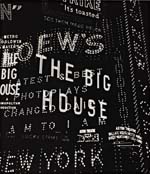Review of Walker Evans at Stanford
I went with a group of Internet photo friends to the Walker Evans show at Stanford on Saturday. Richard Gordon asked me to send a note if the prints in the show were good ones. Here’s an ambivalent answer.
If you’re a disciple or devotee, every Walker Evans show is a good one just because you see some prints again. If you’re an aficionado but more critical – or are less devoted – the Stanford show might seem like ho-hum, more-of-the-same. One nice thing is its scale: It’s the (younger) Fisher family’s collection of Evans’ work, and it seems to have been collected by saying ‘Jeffrey, we’ll take everything you can lay your hands on.’ They don’t seem to have a special collecting eye, they just reach out for one of everything. They’ve missed a few I always want to see again (the watermelon boy, Richard Perkins Contractor, Cherokee Parts Store), but they’ve caught a few I hadn’t seen before or had ignored, including a head-on version of the post office in Sprott, Alabama, with a porch-full of patrons and loungers.

Walker Evans, Broadway, 1930. Gelatin silver print. Lent by Elizabeth and Robert J. Fisher, MBA ’80. © Walker Evans Archive, The Metropolitan Museum of Art
The subway series is well represented in dark prints. Maybe Evans wanted them that way, but I don’t remember seeing them so dark and haven’t seen them reproduced that way. Anyhow the printing accentuates the darkly underground feel.
On Richard’s question of how these particular prints look, the answer is complicated because a wall-sign says they’re prints he made or approved/supervised, but the title cards don’t say which are which & I couldn’t tell which he made and which were by Thomas Brown or Jerry Thompson. Evans wasn’t a consistent printer – maybe he liked them all when he printed them, or maybe he kept some that could have been thrown away. Some, like the famous BW man in Havana, are great, with lovely highlight detail. But you can see he didn’t always care too much: the particular print of the striped New Orleans lady barber that he reproduced in American Photographs was so weakly fixed that now it’s light brown.
I enjoyed the copies of post-war Fortune magazines with his work, but the accompanying text baffled/horrified me. A wall-note said he made ten thousand color transparencies for Fortune – I had no idea there were so many. But the note also said neither he nor the magazine arranged for photo-printing, and so the only versions we have are the aging magazines; no dye transfers or Cibachromes. Because it’s hard to imagine that they exist and nobody has located and reproduced them, I suppose Fortune cleaned out its archives and destroyed its photo-fortune?
What I enjoyed most was seeing finely detailed prints that were small. I’ve fallen in too heavily with the trend toward large prints, and I was re-awakened to the pleasure of exquisite prints that compel the eye to enter them and search search search for the tiniest details: What tiny highlights! And what does that little sign on the wall say? It’s a trip I’ve been missing lately.
Kirk Thompson
